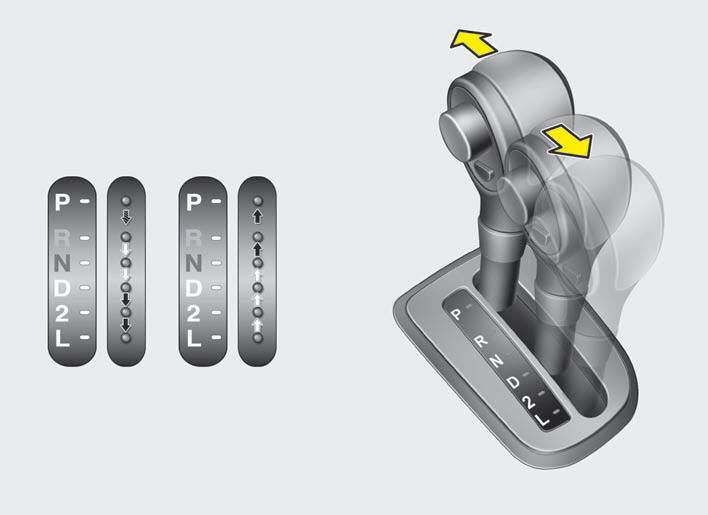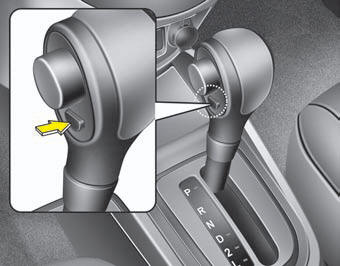Automatic transaxle

Automatic transaxle operation The automatic transaxle has 4 forward speeds and one reverse speed. The individual speeds are selected automatically, depending on the position of the shift lever.
NOTICE
The first few shifts on a new vehicle, if
the battery has been disconnected, may
be somewhat abrupt. This is a normal
condition, and the shifting sequence will
adjust after shifts are cycled a few times
by the TCM (Transaxle Control
Module) or PCM (Powertrain Control
Module).
For smooth operation, depress the brake pedal when shifting from N (Neutral) to a forward or reverse gear.
WARNING - Automatic
transaxle
• Always check the surrounding
areas near your vehicle for people,
especially children, before
shifting the shift lever into D
(Drive) or R (Reverse).
• Before leaving the driver’s seat, always make sure the shift lever is in the P (Park) position; then set the parking brake fully and shut the engine off. Unexpected and sudden vehicle movement can occur if these precautions are not followed in the order identified.
CAUTION
• To avoid damage to your
transaxle, do not accelerate the
engine in R (Reverse) or any forward
gear position with the
brakes on.
• When stopped on an incline, do not hold the vehicle with the engine power. Use the service brake or the parking brake.
• Do not shift from N (Neutral) or P (Park) into D (Drive), or R (Reverse) when the engine is above idle speed.
Transaxle ranges
The indicator in the instrument cluster
displays the shift lever position when the
ignition switch is in the ON position.
P (Park)
Always come to a complete stop before
shifting into P (Park). This position locks
the transaxle and prevents the drive
wheels from rotating.
WARNING
• Shifting into P (Park) while the
vehicle is in motion will cause the
drive wheels to lock which will
cause you to lose control of the
vehicle.
• Do not use the P (Park) position in place of the parking brake.
Always make sure the shift lever is latched in the P (Park) position and set the parking brake fully.
• Never leave a child unattended in a vehicle.
CAUTION
The transaxle may be damaged if
you shift into P (Park) while the
vehicle is in motion.
R (Reverse)
Use this position to drive the vehicle
backward.
CAUTION
Always come to a complete stop
before shifting into or out of R
(Reverse); you may damage the
transaxle if you shift into R
(Reverse) while the vehicle is in
motion, except when “Rocking the
vehicle” explained in this section.
N (Neutral)
The wheels and transaxle are not
engaged. The vehicle will roll freely even
on the slightest incline unless the parking
brake or service brakes are applied.
D (Drive)
This is the normal forward driving position.
The transaxle will automatically shift through a 4-gear sequence, providing the best fuel economy and power.
For extra power when passing another vehicle or climbing grades, depress the accelerator fully, at which time the transaxle will automatically downshift to the next lower gear.
NOTICE
Always come to a complete stop before
shifting into D (Drive).
2 (Second Gear)
Use 2 (Second Gear) for more power
when climbing hills and for increased
braking when going down hills. This position
also helps reduce wheel spin on
slippery surfaces. When the shift lever is
placed in 2 (Second Gear), the transaxle
will automatically shift from first to second
gear.
L (Low)
Move the shift lever to this position in
hard pulling situations and for climbing
steep grades.
CAUTION
Do not exceed the recommended
maximum speed in 2 (Second Gear)
or L (Low). Operating the vehicle
above the maximum speed recommended
for 2 (Second Gear) or L
(Low) may cause excessive heat
which could damage the automatic
transaxle.

O/D (Over Drive) system (if equipped) Pressing the O/D system button cancels and engages the overdrive system.
When the O/D system is cancelled, the O/D OFF indicator illuminates and the transaxle gear range is limited to 1st through 3rd. The transaxle will not shift to 4th gear until the O/D system button is pressed again to release the switch.
When driving down a sloping road with the transaxle in O/D (4th), you can decrease the vehicle speed without using the brakes by pressing the O/D button.
When the ignition is switched OFF, O/D OFF mode is automatically cancelled.
O/D OFF Indicator
This indicator light illuminates in the
instrument panel when the O/D mode is
cancelled.
NOTICE
If the O/D OFF indicator flashes, it indicates
an electrical problem with the
transaxle. Should this occur, have the
vehicle checked by an authorized KIA
dealer as soon as possible.
Shift lock system (if equipped) For your safety, the automatic transaxle has a shift lock system which prevents shifting the transaxle from P (Park) into R (Reverse) unless the brake pedal is depressed.
To shift the transaxle from P (Park) into R
(Reverse):
1. Depress and hold the brake pedal.
2. Start the engine or turn the ignition switch to the ON position.
3. Depress the lock release button and move the shift lever.
If the brake pedal is repeatedly depressed and released with the shift lever in the P (Park) position, a chattering noise near the shift lever may be heard. It is a normal condition.
WARNING
Always fully depress the brake
pedal before and while shifting out
of the P (Park) position into another
position to avoid inadvertent
motion of the vehicle which could
injure persons in or around the
vehicle.
Ignition key interlock system The ignition key cannot be removed unless the shift lever is in the P (Park) position. If the shift lever is in any other position, the key cannot be removed.
Good driving practices
• Never move the gear shift lever from P
(Park) or N (Neutral) to any other position
with the accelerator pedal
depressed.
• Never move the gear shift lever into P (Park) when the vehicle is in motion.
• Be sure the vehicle is completely stopped before you attempt to shift into R (Reverse) or D (Drive).
• Never take the vehicle out of gear and coast down a hill. This may be extremely hazardous. Always leave the car in gear when moving.
• Do not "ride" the brakes. This can cause them to overheat and malfunction.
Instead, when you are driving down a long hill, slow down and shift to a lower gear. When you do this, engine braking will help slow down the car.
• Slow down before shifting to a lower gear. Otherwise, the lower gear may not be engaged.
• Always use the parking brake. Do not depend on placing the transaxle in P (Park) to keep the vehicle from moving.
• Exercise extreme caution when driving on a slippery surface. Be especially careful when braking, accelerating or shifting gears. On a slippery surface, an abrupt change in vehicle speed can cause the drive wheels to lose traction and the vehicle to go out of control.
• Optimum vehicle performance and economy is obtained by smoothly depressing and releasing the accelerator pedal.
WARNING
• Always buckle-up! In a collision,
an unbelted occupant is significantly
more likely to be seriously
injured or killed than a properly
belted occupant.
• Avoid high speeds when cornering or turning.
• Do not make quick steering wheel movements, such as sharp lane changes or fast, sharp turns.
• The risk of rollover is greatly increased if you lose control of your vehicle at highway speeds.
• Loss of control often occurs if two or more wheels drop off the roadway and the driver oversteers to reenter the roadway.
• In the event your vehicle leaves the roadway, do not steer sharply.
Instead, slow down before pulling back into the travel lanes.
• Never exceed posted speed limits.
WARNING
If your vehicle becomes stuck in
snow, mud, sand, etc., then you
may attempt to rock the vehicle free
by moving it forward and backward.
Do not attempt this procedure if people or objects are anywhere near the vehicle. During the rocking operation the vehicle may suddenly move forward of backward as it becomes unstuck, causing injury or damage to nearby people or objects.
Moving up a steep grade from a standing
start
To move up a steep grade from a standing
start, depress the brake pedal, shift
the shift lever to D (Drive). Select the
appropriate gear depending on load
weight and steepness of the grade, and
release the parking brake. Depress the
accelerator gradually while releasing the
service brakes.
When accelerating from a stop on a steep hill, the vehicle may have a tendency to roll backwards. Shifting the shift lever into 2 (Second Gear) will help prevent the vehicle from rolling backwards.
See also:
Tires and wheels
CAUTION
When replacing tires, use the same
size originally supplied with the
vehicle.
Using tires of a different size can
damage the related parts or make it
work irregularly. ...
'Premium presence' for compact new car
With new Rio, Kia has created a car that answers consumer demand for more
quality, more choice, and attractive, exciting design.
This new car is no evolution of its predecessor, it is a revolution ...
Mirrors
Outside rearview mirror
Be sure to adjust mirror angles before
driving.
Your vehicle is equipped with both lefthand
and right-hand outside rearview
mirrors. The mirrors can be adjusted
remotely ...


